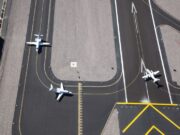Reports
Annual Report to Parliament, 2012–13
Transportation Safety Board of Canada (TSB). June 2013. 46 pp. Appendixes, figures, tables. Available from TSB at <tsb.gc.ca/eng/publications/ann/2013/2012-2013.pdf>.
This report, submitted to the Canadian Parliament, details the TSB’s progress in investigating accidents in aviation and other forms of transportation and its efforts to advance transportation safety.
“Overall, the TSB has been very successful in identifying safety issues and reducing risks in the transportation system,” the report says of the 52 safety investigations completed by the agency in 2012–2013. “Each investigation led to a comprehensive report, identifying critical safety issues and contributing factors, communicating lessons learned and, when necessary, making recommendations aimed at reducing risks. … Our systematic approach ensured TSB resources were invested in areas with the greatest safety payoffs.”
Separate sections on aviation, rail and marine transportation, and pipeline operations discuss the agency’s work in those transportation modes from April 2012 through March 2013.
The report includes annual safety data in each mode for 2012, noting that 1,594 accidents and 1,287 incidents were reported to the TSB. Of that number, 239 accidents involved Canadian-registered aircraft; this represented a 4 percent increase from the 230 accidents reported in 2011 but a 5 percent decrease from the 252-accident average for 2007 through 2011.
Thirty-three of the 239 accidents were fatal crashes in which a total of 54 people were killed. In comparison, 30 fatal crashes in 2011 killed 62 people; the 2007–2011 average was 30 fatal crashes and 58 fatalities. Of the 33 fatal accidents, 11 involved commercial aircraft (six airplanes and five helicopters).
Foreign-registered aircraft were involved in 16 accidents in 2012, including one fatal accident; in 2011, there were 10 such accidents including two with fatalities.
The 2012 data included 636 reported incidents, a 6 percent decrease from the 677 recorded in 2011 and 21 percent fewer than the 2007–2011 average of 808.
During the 2012–2013 period covered by the report, the TSB completed 26 investigations of aviation safety occurrences and began 27. On average, each investigation took 549 days.
In its review of responses to the TSB’s past safety recommendations, the report says 60 percent of its aviation recommendations have received what the agency considers a “fully satisfactory” response.
“Canada has seen a number of aircraft accidents over the past few years that have involved factors relating to these outstanding recommendations,” the report said. “For instance, the TSB has revived three dormant recommendations relating to post-impact fires as a result of ongoing accident investigations.”
The report also said that not enough has been done to address a recommendation that calls on Transport Canada to require airports with runways that are at least 1,800 m (5,906 ft) long to have 300-m (984-ft) runway end safety areas “or a means of stopping aircraft that provides an equivalent level of safety” (“Working Safely on an Operative Runway,” p. 12).
Only one of eight aviation safety items on the TSB’s “watchlist” of critical recommendations — calling for installation of ground-proximity warning systems in some classes of aircraft — has received a “fully satisfactory” response, the report said, describing the response to other items as “troubling.”
NextGen Implementation Plan
U.S. Federal Aviation Administration (FAA) Office of NextGen. June 2013. 98 pp. Appendixes, figures, tables. Available from the FAA at <www.faa.gov/nextgen>.
In this report, the FAA outlines its ongoing transition to the Next Generation Air Transportation System (NextGen), which modernizes the U.S. National Airspace System (NAS) with new technologies and procedures intended to enhance safety and efficiency.
Automatic dependent surveillance–broadcast (ADS–B), the satellite-based successor to radar tracking, is among the NextGen programs that already have been widely implemented.
“By February 2013, we had deployed more than 500 of about 700 ADS–B ground stations,” the report said. “This year, the FAA is continuing to work with industry to develop the best approach for aircraft operators to equip for NextGen. Our ADS–B work is driven by the fact that aircraft flying in designated airspace must be equipped to broadcast their position to the ADS–B network by Jan. 1, 2020.”
The FAA has continued to expand the number of satellite-based precision arrival and departure procedures and high- and low-altitude routes in an effort to “save fuel, reduce emissions, increase flexibility in the [NAS] and facilitate more dynamic management of air traffic,” the report said.
The report also described progress with metroplex-level work — an effort to implement satellite-based procedures and airspace improvements to reduce fuel consumption and emissions in defined urban areas with several airports.
“As of January, we had eight active metroplex areas in various phases of development,” the report said, noting that North Texas and Houston were to be added soon.
The report said the FAA envisions significant improvements in all phases of flight within the next decade.
“Technologies such as ADS–B and data communications, combined with performance-based navigation (PBN), will increase safety and capacity and save time and fuel, decrease aircraft emissions and improve our ability to address noise,” the report said. “With NextGen, we continue to advance safety as we look to increase air traffic and introduce new types of aircraft, such as unmanned aircraft systems and commercial space vehicles. The aviation community continues to rely on safety management systems (SMS) to continue to minimize risk as we bring together a wave of new NextGen capabilities.”
Weather detection and forecasting capabilities also will be improved through NextGen programs, resulting in improved air traffic planning and more efficient weather-related rerouting, the report said.
Individual sections of the report add more details about surveillance and navigation improvements being achieved through NextGen, the system’s benefits for general aviation and how the NAS will change in the future.
“Step by step, we are approaching a tipping point at which 20th-century systems and technology will give way to those of the 21st,” the report said.
Regulatory Materials
Reporting Wildlife Aircraft Strikes
U.S. Federal Aviation Administration (FAA) Advisory Circular (AC) 150/5200-32B. May 31, 2013. 11 pp. Tables.
Wildlife strikes are to blame for about $718 million in aircraft damage and 567,000 hours of civil aircraft down time each year in the United States, the FAA says in this AC, which explains recent improvements in the FAA’s Bird/Other Wildlife Strike Reporting System.
From 1990 through 2011, more than 115,000 wildlife strikes were reported to the FAA. Of these, 97 percent involved birds. Most of the strikes associated with a loss of human life involved European starlings, but ducks, geese, gulls and raptors (primarily hawks and vultures) were responsible for the most damage to civil aircraft. Vultures, ducks and geese are blamed for the most losses to U.S. military aircraft, the AC says.
The document says that although reporting of wildlife strikes has increased over the past two decades, reporting rates are still low for some segments of the aviation community. For example, the AC says some general aviation airports file wildlife strike reports at a rate that averages less than one-twentieth of the rate at U.S. Federal Aviation Regulations Part 139 airports (those that handle larger commercial traffic). The largest Part 139 airports, especially those with wildlife-hazard management programs, file reports at about four times the rate of other airports operating under Part 139, the AC says.
A similar reporting pattern is found among airlines of varying sizes, the AC says.
The AC says the FAA “strongly encourages pilots, airport operations, aircraft maintenance personnel, air traffic control personnel, engine manufacturers or anyone else who has knowledge of a strike” to report it to the FAA National Wildlife Strike Database. Reporting forms are available online at <faa.gov/go/wildlife> and, for mobile devices, at <faa.gov/mobile>. Reporting forms also are available from airports district offices, flight standards district offices and flight service stations, and from the Airman’s Information Manual.
If airport personnel or local biologists cannot identify the type of bird involved in a bird strike, the remains may be submitted to the Smithsonian Institution’s Feather Identification Lab for identification. The AC includes detailed instructions on how to prepare remains for mailing.
This AC cancels its predecessor, AC 150/ 5200-32A, issued Dec. 22, 2004.
Digital Media
International Civil Aviation Organization (ICAO) Safety Management Website
<icao.int/safetymanagement>
ICAO has introduced a new section of its website designed to help state regulators in implementing the Standards and Recommended Practices of the new Annex 19, Safety Management, which will take effect in November — the first new annex in more than 30 years.
“Annex 19 consolidates safety management provisions contained in six other ICAO annexes and will now serve as a practical one-stop resource for states and industry,” ICAO said.
The organization said the new section of the website is intended to support improvements in aviation safety as the aviation industry enters what is expected to be a period of considerable growth.
“Aviation safety is today as good as it has ever been, with 2012 recognized as the safest year in the history of commercial aviation,” said ICAO Secretary General Raymond Benjamin. “But with the projected doubling of air traffic by 2030, it became imperative that ICAO adopt a comprehensive safety management framework to maintain and improve upon our sector’s remarkable safety performance.”
Various sections of the website discuss not only the specifics of Annex 19 but also the Global Aviation Safety Plan, which establishes specific safety objectives while ensuring “the efficient and effective coordination of complementary safety activities between all stakeholders,” and safety management training material, including material for state safety programs and safety management systems.
Another section, for registered representatives of ICAO member states, is set aside for the integrated Safety Trend Analysis and Reporting System (iSTARS), which connects a number of sets of safety data and a related web application that are used in risk analysis



